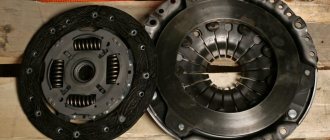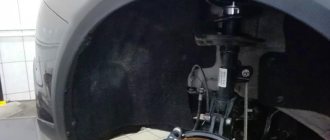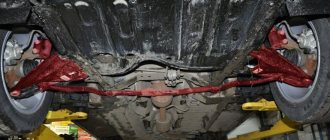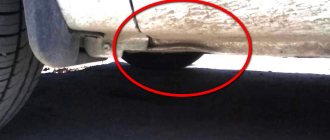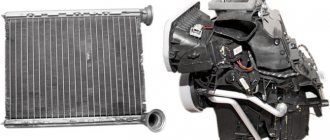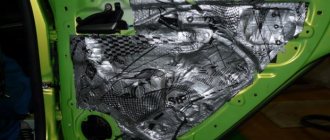Motor operation
The standard 1.8-liter power unit with a capacity of 122 horsepower is characterized by fairly high fuel consumption and a low level of dynamics. In addition, the engine consumes a lot of engine oil.
Vibration, tripping, and failures in engine operation are also typical problems of this model. This is especially noticeable when you press the accelerator pedal.
Another typical problem with Togliatti cars is floating engine speeds. This deficiency has existed for many decades.
However, no improvements have been noted since then. But sellers often deny obvious problems, explaining this phenomenon by the poor quality of fuel materials.
The suspension has at least 4 minuses
During the first months of operation, the Lada Vesta caused the greatest criticism regarding its suspension. Many car enthusiasts complain about various knocks and squeaks. Motor design problem:
- front anti-roll bars, which produce a characteristic creaking sound when the Lada Vesta travels long distances;
- stabilizer struts are knocking;
- sounds appear in the front suspension when turning the steering wheel;
- The shock absorbers in the rear suspension are knocking due to the poor design of the supports, which are being replaced with more elastic and self-absorbing ones.
On average, after 4-6 thousand kilometers, Lada Vesta owners notice and complain about the creaking of the stabilizer rubber bands when going over bumps on the road.
After a run of 40-50 thousand kilometers, play may appear in the lower bearings of the steering knuckle. Low mileage rates according to the average statistical data of the operation of similar units.
Knocks in the suspension
In general, West levers last quite a long time. Extraneous noise may come from shock absorbers and stabilizer struts. The latter, by the way, sometimes did not live to reach 10 thousand km. Over time, the plant produced improved parts.
It is worth noting that car dealers agree to replace shock absorbers only in the case of clearly visible oil leaks. If the noise-producing elements are dry, the owner may be refused repairs.
Lada Vesta: eternal damnation or temporary difficulties?
Lifehacks
The main complaints from consumers concern the domestic 1.6-liter engine with 106 horsepower. The most common problems: the engine “troubles”, and at idle the speed “floats”. All this is accompanied by irritating vibrations, a decrease in unit power (one cylinder does not work) and an increase in fuel consumption. Dealers consider this problem individually, since it depends on many factors, including the most common one - fuel quality. For example, our test car (with a 106-horsepower engine and five-speed manual transmission) did not have such a problem. But the second “sore” showed itself: the engine does not start immediately, but after several seconds of starter operation. Simply put, not with half a turn, as any engine should start.
Plus, after they began installing the Russian VAZ-21807 gearbox on the Vesta (previously it had a Renault transmission), complaints arose about unclear gear shifting and whining. AvtoVAZ corrected the gear shift mechanism itself, but the annoying transmission noise remained.
Also, many Vest owners complained that even after a short mileage the exhaust system began to rattle loudly. The problem turned out to be that the rubber hangers through which the release was attached quickly fell apart.
And the brackets to which they clung were simply poorly welded. Fortunately, Togliatti engineers have long changed the technological welding schemes and the composition of the rubber mixture from which the hangers are made.
After two months of testing and more than 2,000 km of mileage, the test car showed no problems with the exhaust system.
That's how we got to the “delicious” part - to the complaints about the chassis. The first is the creaking of the anti-roll bar bushings when driving through potholes. On the test car, the creaking continued until we lubricated these silent blocks. However, Russian engineers promised to review this element in the near future.
The second is the knocking of the stabilizer struts at short runs. This element, unlike the aforementioned bushings, was quickly modified, and on new Vestas the struts begin to play much later (average service life is 30-50 thousand km).
Third, another portion of knocks, but now from the rear suspension. Vesta has a simple one from Renault Zoe: a torsion beam with a torsion bar inside and springs with shock absorbers. VAZ workers found out that the cause of the unpleasant knocking was the rubber shock absorber mounts. The problem was solved simply: we changed the material to a softer one.
And finally, fourth - weak shock absorbers. When our sedan’s mileage exceeded a thousand kilometers, the front shock absorbers began to slowly “sweat.” Of course, there is no need to change them, but, you see, the fact is definitely unpleasant. Considering that the average service life of shock absorbers is 30-50 thousand km. Whether AvtoVAZ is going to do something about this is unknown.
To summarize, Lada Vesta, despite “childhood illnesses” and poor build quality, is a worthy domestic product. Vesta has good dynamics, an elastic suspension, a nice design, and in general the car is more or less pleasant to use. It’s a pity only for the owners of cars from the first years of production, who, in fact, gave their money to be in the role of experimental subjects.
Alexey Dergachev
The editors would like to express their gratitude to the Vilgud Ochakovo car service center and General Director Peter Tsimbal for their assistance in preparing the material.
Lada Vesta from ZR Park: sores of “fifty dollars”
The original stabilizer struts were purchased at a price of 610 rubles apiece. We replaced it ourselves, using the forces of our technical center in Tushino. The photo shows the dismantled racks. Only one hinge out of four became unusable.
As I expected, the knocking stabilizer struts, which I complained about during the third maintenance, were not covered by the warranty. Having scoured the Internet, I was amazed at the variety of analogues that the owners of West are installing to replace the original that suddenly died. The length (275 mm) of the Lada fits “bones” from Japanese and Korean models and even from “Europeans”. There are a lot of options from different manufacturers, for every taste and budget: from 500 rubles per pair to 2000–3000 rubles per piece. The most expensive ones are the original from Toyota or BMW. Moreover, the inspectors supply not only exactly the right size substitutes, but also parts of different lengths in the range from 270 to 285 mm. In my opinion, this is a dubious practice. And also unsafe.
I decided to check AVTOVAZ’s assurances that the currently produced struts have already been modified and have a long service life. The price for branded VAZ parts in Moscow varies from 440 to 660 rubles per piece. I bought racks in a company store, paying 1220 rubles for a pair. By the way, the result of our Vesta (the knocking sound appeared at 43,000 km) can be called excellent. Other owners changed the stabilizer struts long before the 10,000 km mark! It’s interesting that, based on the results of the inspection, our Tushinsky technicians recognized only one hinge out of four (the lower one on the left side). At the same time, it knocked so hard that I wanted to shake up the entire suspension. Now I enjoy the silence while driving and wonder how long it will last.
The increased consumption of engine oil noticed before the third maintenance has not yet manifested itself. Of course, the oil was replaced with the correct one. Now it’s not Elf, but Rosneft. But if the reason for the increased oil consumption lay in the engine, the level on the dipstick would continue to decrease. The condition of the clutch is also pleasing. Having covered 12,000 km, it behaves perfectly even in autumn Moscow traffic jams: no jerks, no hints of overheating. Such feats were beyond the capabilities of the previous clutch. I am very glad that AVTOVAZ managed to correct the unpleasant defect. The manufacturer is the same - Valeo, but the index of the modernized clutch disc is 21703-1601130-31 (previously part 21703-1601130-30 was used).
Our Vesta again sports the brand nameplates that were removed when painting the trunk lid. For a long time I couldn’t find them in stock, but then I found them both in the same store. The asking price is 765 rubles for two ornaments.
Our Vesta again sports the brand nameplates that were removed when painting the trunk lid. For a long time I couldn’t find them in stock, but then I found them both in the same store. The asking price is 765 rubles for two ornaments.
Having traveled to Sochi in the Vesta SW and Vesta SW Cross station wagons, I, of course, was overcome with black envy. Three-stage seat heating, a separate button for heating the windshield, a full-fledged front armrest with a box - these are just some of the improvements that the owners of the first Vestas can only drool over. But there was also something in which the editorial machine turned out to be better. In my opinion, it’s not worth paying extra for a 122-horsepower 1.8 engine. The 1.6-liter one, which is installed on our Vesta, is enough. The dynamics of the more powerful unit are noticeable only when overtaking on the highway. There are no more advantages. However, without elasticity measurements, these conclusions remain at the level of subjective sensations. But you will have to pay for increased fuel consumption every day. The official technical specifications say: a sedan with a robot and a 1.8 engine is 0.3–0.7 l/100 km more voracious than a similar version with a 1.6-liter unit by 0.3–0.7 l/100 km, depending on the driving mode. And with a manual transmission the difference is even more noticeable - 1.0–1.2 l/100 km! And judging by the reviews of the owners, this is so.
Assembly and layout is a problem of the Russian automobile industry
On the one hand, the VAZ corporation has created a revolutionary car, and the consumer begins to look for various problems. On the other hand, for this money you can buy a number of other cars, so the consumer has the right to criticize the car for certain shortcomings. Assembling cars has never been AvtoVAZ's strong suit, but this time everything turned out to be not so bad. The main problems are:
- many interior elements do not work as you would like, the seats do not fold comfortably enough, the driver’s seat adjustments are quite difficult;
- the assembly of the plastic elements of the interior is more or less normal, but creaking appears already in the first thousand kilometers;
- The quality of the interior trim is quite poor, the seat fabric is very ordinary, and the plastic is very hard; the quality of tailoring of all fabric elements is also criticized;
- The gaps between the body parts are ideal, but the body turned out to be dynamic, these gaps are constantly floating and shifting, albeit not in the visible spectrum of sizes.
Scratched glass
Scratches on the side windows can be seen on many Vestas.
Another problem for Vesta, which appeared immediately after the start of sales. Vertical scratches appeared on the side windows in just a few lifting and lowering cycles. It was all blamed on the door seals being too rigid and too close together.
Dealers cut them and changed them, but, according to our observations, it helped little. Judging by the number of abrasions and small chips on the windshield of the editorial car, Vesta uses too “soft” glass. But here the plant did not make any changes: they continue to install the same Sisecam on the cars.
The suspension has at least 4 minuses
During the first months of operation, the Lada Vesta caused the greatest criticism regarding its suspension. Many car enthusiasts complain about various knocks and squeaks. Motor design problem:
- front anti-roll bars, which produce a characteristic creaking sound when the Lada Vesta travels long distances;
- stabilizer struts are knocking;
- sounds appear in the front suspension when turning the steering wheel;
- The shock absorbers in the rear suspension are knocking due to the poor design of the supports, which are being replaced with more elastic and self-absorbing ones.
On average, after 4-6 thousand kilometers, Lada Vesta owners notice and complain about the creaking of the stabilizer rubber bands when going over bumps on the road.
After a run of 40-50 thousand kilometers, play may appear in the lower bearings of the steering knuckle. Low mileage rates according to the average statistical data of the operation of similar units.
The exhaust corrugation is rusting
Domestic cars have always had a short-lived exhaust system, and Vesta was no exception, where the corrugation rusts very quickly. At first, nothing gives this away, the sound is quite familiar, but soon the roaring car ends up being serviced. This may happen within the warranty period, so do not miss the opportunity. It is interesting that in the first years of Vesta sales, the corrugation was covered by a warranty of only 35 thousand km or a year, but after criticism it was made standard: 100 thousand km or 3 years.
Gearboxes
Unfortunately, it is not hardy for a number of reasons:
- weak synchronizers (especially second gear);
- not very durable clutch (a large number of complaints that the clutch smells during moderate slipping in the snow);
- problems with the gearbox robot (frequent complaints are a torn, jerky start from a standstill, large vibrations when starting from a standstill);
- setup, calibration of electronics;
- characteristic traction failures that occur when overtaking;
- oil starvation of the upper shafts (in addition, the designers reduced the oil level in the box);
- An important fact is the clutch installed in the AMT, from the Italian company Valeo, it is considered quite reliable. But its service life does not exceed 80-100 thousand km with careful driving - a paradox.
Not everything is so rosy for Vesta with gearboxes. The mechanics are characterized by weak synchronizers, this is especially noticeable in second gear, therefore, with increasing service life, it begins to resist when switched on, and in cold weather it can turn on even worse.
Vesta has even more problems with the robot, and with the same clutch. A common complaint against manufacturers is a jerky start. The reason for this may be warping of the clutch disc: this is the most common problem with all types of “robots”.
It is almost impossible to solve this problem on your own. However, since October 2021, AvtoVAZ began installing more “heat-resistant” clutches on Vesta, so this is a problem with the first generations of the car.
Sometimes there are problems with installing autostart: there have been cases when a car with robots started moving in remote start mode. The robot can safely be called Vesta’s weak link. It often makes the driver nervous: slow operation and failures in traction during acceleration can make anyone nervous, although starting from a standstill seems to be set up well.
What to look for when buying LADA Vesta
The first concept art of the LADA Vesta, presented in 2014 in Izhevsk, attracted the attention of car enthusiasts. In 2015, the production of the model was successfully launched by the AvtoVAZ conveyor.
Under the hood, depending on the configuration, hides from 87 to 106 “horses” from the manufacturer’s concern; there is an installation option HR16DE-h5M from the Japanese manufacturer with a power of up to 110 horsepower. The engine capacity is 1.6 liters. Since 2021, a 1.8 liter and 122 hp engine has been added. Fuel consumption in city mode is 9.3 l/100 km. Also a 1.8 liter engine. got under the hood of Vesta SW Cross. Unfortunately, its power is not enough for a rather heavy crossover. And fuel consumption is 10.7 l/100 km.
“Fact: when assembling this Lada model, the manufacturer used only 20% of domestically produced components.”
A little about the advantages
Buyers, comparing the car with its direct competitors like KIA Rio and Hyundai Solaris, note the advantages of the car:
- Easy and responsive control system;
- Spacious interior and luggage compartment;
- The car is equipped with safety control sensors, which, if necessary, can not only limit the speed of the car, but also inform the emergency service about an accident;
- Buyers paid attention to the increase in car comfort;
- With a maximum vehicle load (trunk and passengers fully seated), the ground clearance starts at a minimum of 17.1 cm.
Pros and cons are present in any model, even the most popular brands, but the disadvantages of the Lada Vesta begin to be evident with a mileage of 3 thousand km.
Cons of LADA Vesta
Unfortunately, Vesta’s sores become noticeable after the first few thousand km. mileage And at the dealership, when applying for warranty service, they will not always help. Let's look at the main weak points of the LADA Vesta SW Cross:
- Salon;
- KP;
- Chassis;
- Electronics;
- Exhaust system.
Let's take a closer look...
Vehicle interior
Vesta’s painful spots in the cabin do not appear immediately. The first thing that will bother a car owner is “crickets”. The creaking of plastic parts of the dashboard due to the lack of seals is annoying, but can be easily fixed by installing new gaskets.
The cover on the steering wheel quickly loses its appearance, and when the heating fan is turned on at speeds 4 and 5, the steering wheel vibrates. The door trim is coming off
Car owners note that it is difficult to read data from the dashboard, which is partially covered by the steering block. The absurdity and quality of the driver's armrest, which was not provided for the passenger in front.
Transmission
Dips or significant waiting periods between gear changes have become an unpleasant bonus for car owners. The reason lies in a factory firmware error and this problem can be solved by an authorized dealer.
The problem of rapid wear (80-100 thousand km) of the Italian Valeo clutch, which AvtoVAZ screwed to the AMT robotic transmission, greatly facilitates the owners of this car assembly.
When reaching the mark of 15 thousand km. mileage, problems with bearings and difficult gear shifting on manual transmissions were noticed.
Chassis
Weak struts - this is a problem that AvtoVAZ justified as a poor supplier of components; it makes itself felt after 3 thousand km. Fortunately, this can be resolved under warranty conditions.
The next problem is the play that appeared in the lower support of the steering knuckle after reaching the 30 thousand km mark. But AvtoVAZ solved the problem here too by changing the liner housing, after which the wheels stopped squeaking when turning.
“Paper” wheels is a metaphorical description of factory wheels, which has taken root among Vesta owners. They got their name for their ability to bend when they get into any small hole on the road.
Electronics
Dissatisfied with the quality of the picture on the MMC display, Vesta owners note that the rear view camera turns off while operating in AUX mode. Bluetooth disconnection, freezes, after which you need to resort to Hard Reset.
A failure of the heated windshield due to firmware or fuses has been noticed. And also a breakdown of the ignition coil, which is replaced under warranty.
Exhaust system
The car has quite a lot of shortcomings, which appear precisely at the 30 thousand km mark. mileage One of these problems is sagging rubber bands on the muffler mount, which is characterized by an easily recognizable knock of the muffler on the tunnel.
Another drawback is the steel nuts that secure the brackets to the exhaust exhaust pipe.
The main problems that arise with the body when operating Vesta SV Cross:
- The first problem is the rapid wear of the bumper paint;
- Pre-installed factory wipers are a low quality part, and after the first 3 thousand km. The windshield may become scratched. Car enthusiasts advise changing wipers immediately after purchasing a car;
- The seals adhere too tightly to the side windows of the car; if sand particles and other contaminants get in, squeaking and scratches may occur on the windows. AvtoVAZ recommends dismantling 2 sides of the seal;
- In the first release models, dirt accumulated under the hood, since a piece of seal was missing in the area of the hood lock. A rather annoying minus that can lead to damage to electronic and other devices in the engine compartment;
- Another drawback, but not so significant, is the creaking of the door hinges during a fairly short period of use.
Results.
This is where the main shortcomings of the Lada Vesta end, leaving room for minor quibbles. One thing is worth noting for sure: AvtoVAZ has produced a high-quality car, which, with proper modification, will gain wide popularity over time. Moreover, many problems that arise with the car are solved under warranty. Newer Vesta models are distinguished by the work they have done to correct errors. AvtoVAZ promptly responds to customer dissatisfaction and tries to correct shortcomings as soon as possible.
PS: Dear car owners, we ask you very much, if you have identified systematic breakdowns of any components, assemblies or parts of this car model, please report them in the comments below. We will jointly keep statistics on the weaknesses and shortcomings of this model.
polomkiauto.ru
Characteristics of motor 21129
On the one hand, the 21127 engine, which served as the base version for the creation of 21129, is in turn a tuned modification of 21126, so most of the components in the engine remained the same to reduce production costs. From another point of view, the manufacturer took into account the disadvantages of upgrading its subsidiary to the ICE 21128, so the final engine diagram looks like this:
- the cylinder diameter and piston stroke remained classic for front-wheel drive engines - 82 mm and 75.6 mm, respectively;
- the gas distribution mechanism of the engines remained unchanged - DOHC with two overhead camshafts;
- the cylinder head, connecting rod-piston group and cylinder block have not undergone any changes;
- the entire intake tract with an integrated receiver, DBP and DTV sensors instead of the mass air flow sensor has been preserved;
- the attachments have been partially changed - new pillows, generator and exhaust manifold;
- The engine cooling system and fuel injection have been improved.
The most important feature of 21129 was the new version of the ECM firmware - M86. As a result, gasoline consumption decreased, torque and power increased to 148 Nm and 106 l
s., respectively. That is, the modernization did not affect the volume of combustion chambers of 1.6 liters.
A full description of the motor parameters is given in the instructions, and the main technical characteristics of 21129 are contained in this table:
| Manufacturer | AvtoVAZ |
| Engine brand | 21129 |
| Years of production | 2015 – … |
| Volume | 1597 cm 3 (1.6 l) |
| Power | 78 kW (106 hp) |
| Torque moment | 148 Nm (at 5800 rpm) |
| Weight | 110 kg |
| Compression ratio | 10,5 |
| Nutrition | injector |
| Motor type | in-line |
| Injection | distributed electronically controlled |
| Ignition | coil for each spark plug |
| Number of cylinders | 4 |
| Location of the first cylinder | TVE |
| Number of valves on each cylinder | 4 |
| Cylinder head material | aluminum alloy |
| Intake manifold | combined with receiver, polymer, built-in damper, DTV and DBP sensors |
| An exhaust manifold | catalyst |
| Camshaft | 2 pcs., marks on pulleys are offset by 2 degrees |
| Cylinder block material | cast iron |
| Cylinder diameter | 82 mm |
| Pistons | lightweight, manufacturer Federal Mogul |
| Crankshaft | from 11183 |
| Piston stroke | 75.6 mm |
| Fuel | AI-95 |
| Environmental standards | Euro 5 |
| Fuel consumption | highway – 5.3 l/100 km mixed cycle 6.6 l/100 km city – 9 l/100 km |
| Oil consumption | maximum 0.1 l/1000 km |
| What kind of oil to pour into the engine by viscosity | 5W-30 and 10W-40 |
| Which engine oil is best by manufacturer | Liqui Moly, LukOil, Rosneft, Mannol, Mobil |
| Oil for 21129 according to composition | synthetics, semi-synthetics |
| Engine oil volume | 3.5 l |
| Operating temperature | 95° |
| Motor life | declared 200,000 km actual 300,000 km |
| Adjustment of valves | hydraulic compensators |
| Cooling system | forced, antifreeze |
| Coolant quantity | 7.8 l |
| water pump | with metal impeller |
| Candles for 21129 | BCPR6ES from NGK or domestic AU17DVRM |
| Gap between spark plug electrodes | 1.1 mm |
| Timing belt | Gates, width 22 mm, service life 200,000 km |
| Cylinder operating order | 1-3-4-2 |
| Air filter | Nitto, Knecht, Fram, WIX, Hengst |
| Oil filter | catalog number 90915-10001 replacement 90915-10003, with check valve |
| Flywheel | increased damper size |
| Flywheel mounting bolts | box MT – M10x1.25 mm, length 26 mm, groove 11 mm box AT – M10x1.25 mm, length 26 mm without groove |
| Valve stem seals | code 90913-02090 inlet light code 90913-02088 exhaust dark |
| Compression | from 13 bar, difference in adjacent cylinders maximum 1 bar |
| XX speed | 800 – 850 min -1 |
| Tightening force of threaded connections | spark plug – 31 – 39 Nm flywheel – 62 – 87 Nm clutch bolt – 19 – 30 Nm bearing cap – 68 – 84 Nm (main) and 43 – 53 (rod) cylinder head – three stages 20 Nm, 69 – 85 Nm + 90° + 90° |
Other shortcomings
The result of the still crude product was the following:
- rubbing of the cooling system pipes;
- sagging rubber bands for attaching the muffler (rubber bands are enough for 20-30 thousand km);
- problems with the exhaust resonator (there are cases of burnout at 60-80 thousand km);
- there is no lock on the gas tank cap - we don’t live in 90, but they can try to drain the gas;
- The decorative caps on the alloy wheels, which are located in the center of the hub, fly off.
- Weaknesses in the Chevrolet Aveo T250 The most possible first malfunctions and diseases of the Chevrolet Aveo
- Top 5 most terrifying facts about Hyundai Creta
- Review of KIA Sportage 3 (Kia Sportage 3) with mileage 2010-2015. Review
- Lada Granta engine malfunctions
Minor assembly problems of Lada Vesta
Small niggles, although they do not threaten huge inconveniences, can become the subject of dissatisfaction for the car owner for a long time:
- the pedal platform is very narrow compared to the most comfortable models;
- rear visibility of the glass is not extensive enough to see the entire space behind;
- The Lada Vesta windshield very often suffers from malfunctions in the heating function;
- ABS is an extremely sensitive system, which somewhat interferes with driving and starting;
- There is no lock installed on the vehicle's gas tank cap.
The priority task for improving the overall quality of VAZ’s own cars is the elimination of factory defects by the plant during assembly. The owner is obliged to send his complaint and notify dealers that a particular part has broken down, thereby indirectly improving the entire Russian auto product.
Alarm Lada Vesta
AMT
AVTOVAZ solved the problem with clutches by releasing a modernized unit.
Perhaps the subject of the loudest discussion around Vesta was the clutch life of the robotic gearbox.
At first, everything was really bad with him. If you start driving with a new set in the warm season, then jerks when starting off appear already at 5000–7000 km. It was saved by the arrival of winter, when the problem manifested itself to a lesser extent.
Our editorial machine was not spared from the malfunction. The first set covered 20,000 km, the second - 18,000 km. The third one was already reinforced, which by that time appeared both at dealers and on the factory assembly line. And now, having covered 42,000 km, it shows no signs of wear. Problem solved!
True, a new question was born: how will the new robot firmware with a “crawling” mode and accelerated gear change affect the clutch life?
Chassis
Another source of intrusive knocks and clunks when driving is the suspension. This problem is systemic. Creaks when crossing speed bumps appear due to a strong twist of the stabilizer joints, about which the manufacturer, with a certain amount of cunning, stated that this was supposedly the fault of the brutal Russian roads.
Over time, AvtoVAZ introduced more durable and elastic vulcanized bushings.
Often the cause of knocking in the front of the car was the stabilizer struts due to play in the ball joint. Over time, AvtoVAZ eliminated this problem by changing the shape of the liner body. The squeaks that occur when turning the wheels were also promptly eliminated. In the first models, knocking was also heard from the rear due to the poor design of the shock absorber support. Subsequently it was made softer.
There are complaints from drivers about spontaneous turning of the steering wheel while driving, which most likely occurs due to the operation of the electric power steering.
What engines are installed on the Lada Vesta?
One can note the following list of problems faced by the owners of the very real Vesta, who published their reports in a well-known auto publication. After 14,000 km, the car began to have problems with the robot: at the beginning of the movement, jerks, jerks and impacts began to be recorded. The problem was solved by replacing the driven disk with the clutch basket. After 20,000 km disadvantages:
- The jack was dented.
- The open interior light began to blink due to a poorly adjusted hood switch.
- The windshield heating function is ineffective in cold weather below -10 °C.
- Automatic door locks do not always work.
- The coolant temperature gauge shows incorrect values when the engine is fully warmed up.
- The windshield wiper arms have peeled off.
DETAILS: Replacing the coolant of a VAZ 2110 How to change antifreeze with your own hands
During the period of 40,000 - 45,000 km, the following problems arose on Vesta:
- The rope on the handbrake stretched and it began to rest against the armrest in the working position.
- A knocking sound appeared in the front suspension due to play in the stabilizer struts.
- The trunk lock and door hinges creaked due to poor lubrication.
- The front brake pads are worn out.
- The low beam lamp has burned out.
- Due to the tired muffler corrugation, the sound of the exhaust system increased.
- The interior door handles began to creak.
- The rear seat backrest lock began to creak.
- A lot of crickets appeared in the cabin.
Three power units have been supplied for the new product, two of which are domestic and one is imported:
- VAZ 21116 – 1.6 liters, 8 valves, 87 l. With.;
- VAZ 21127 - 1.6 liters, 16 valves, 106 l. With.;
- Renault-Nissan HR16DE-H4M – 1.6 liters, 16 valves, 114 liters. With.
Weaknesses of Lada Vesta
Lada Vesta has been produced at AvtoVAZ facilities since November 2015.
The article selects all the weaknesses of Vesta that have been identified by car owners at the moment. The line of power units consists of three gasoline engines: 11189, 21129, HR16DE-H4M. The latter is an imported engine produced by the Renault-Nissan alliance. It is installed on such Nissan car models as: Note, Qashqai, Juke, Tiida. The total share of Russian-made spare parts is 20%. Reviews from West owners speak positively about the car, but there are still some shortcomings that may await you soon after purchase and active use. Our infographics contain the most current and most common Vesta diseases, so this information will help owners of the new model prepare for possible problems and find out the weak points of the Lada Vesta.
A very common problem is weak stabilizer links . The problem was noticed on the first Lada Vesta. Literally after 3 thousand kilometers they begin to tap. There is also the creaking of stabilizer rubber bands on smooth metal when moving over bumps. The creaking is eliminated under warranty by sanding the smooth surface of the metal with sandpaper. AvtoVAZ argues this problem is a bad supplier, which has already been replaced by a supplier of better quality racks.
At a mileage of 30 thousand km, play may appear in the lower bearings of the steering knuckle . Subsequently, AvtoVAZ eliminated the play of the ball joint by changing the liner housing, which also simultaneously solved the problem of squeaks when turning the wheels.
Factory alloy wheels are so weak that they bend when the wheel gets into even a small hole, which is why you can often hear them called “paper”.
Transmission:
Errors in the automatic transmission algorithm , the automatic transmission can be thoughtful at times, and “nodding” occurs when changing gears. The reason for this is a glitch in the first firmware. It can be solved by reflashing it from an official dealer. As for the manual transmission, the situation is better; only on some of the first Vestas with manual transmission do difficulties appear in shifting gears .
After 15,000 km, on some manual gearboxes from Renault (JH3), the bearing began to howl, and 1st, 2nd and 3rd gears were difficult to engage (the rod blocking block stuck in its hole).
Cricket behind the instrument panel . It can be eliminated quite easily by removing the panel and installing sealing materials under the creaking plastic.
The paint on the steering wheel lining wears off quickly . Moreover, even after a warranty replacement, abrasions quickly appear.
At 4th or 5th speed of the heater fan, vibration appears on the steering wheel . This is due to contamination of the impeller. By the way, in the cars of 2021, this problem was not solved in Vesta.
The trim on the rear doors is coming off .
There is a knocking sound from the cables under the side door trim. It can also be easily removed by fixing them. All these problems concern the first releases of Vesta; most likely, they will be corrected in the future, because as practice shows, AvtoVAZ reacts quite quickly to emerging childhood problems.
Electronics:
Multimedia glitches , there are many complaints that when AUX mode is running on the multimedia system, a black screen appears when the rear view camera is turned on. Or the multimedia does not start at all unless you do a hard reset. Most likely this is also a temporary problem with the first machines, which will be eliminated with new firmware.
There are also cases of the heated windshield not working. Possible reasons: either the firmware or the fuse (there are two of them).
The ignition coil was noticed to fail (on cars from the first batch), it was replaced under warranty.
Door limit switches begin to fail at 20 thousand mileage.
When driving around 3 thousand km, when using standard frame wipers, scratches appear on the windshield . Here it’s like on old VAZs - “buy a new car and immediately change the wipers.” The case is under warranty and the official dealer will replace the glass.
The front and rear bumpers suffer greatly from chips and scratches, and the paint on it begins to peel off along with the varnish.
Another common drawback of Vesta is that the velvet covers fit too tightly to the side windows. If sand gets in and you still use the power windows, scratches will form on the side windows , the appearance of which is accompanied by a squeaking sound. The official instructions from AvtoVAZ in this case are to cut off two sides of the seal.
There have been cases of dirt accumulating under the hood due to the absence of a section of the hood seal in the lock area . Dirt not only spoils the appearance, but is also harmful to engine compartment devices, such as the generator, belts, electricians, and the like. This problem is relevant for the Lada Vesta of the first releases. Can be cured by installing another seal.
And after six months of operation, the door hinges may begin to creak, naturally, after lubrication everything goes away, but the very fact that the factory lubrication is not enough for a long time is a little upsetting.
The headlights themselves are fine, but for some reason the turn signals on the side rearview mirrors
Exhaust system:
After 30 thousand km, the rubber bands securing the muffler begin to sag and these “carrots” simply break.
Breaking off of brackets on the exhaust exhaust pipe - steel nuts were used instead of brass.
What changes have taken place in Vesta cars of 2021 and 2021?
These are, in principle, all the problems that a car can suffer from. Yes, it is damp and expensive when compared with Korean counterparts like Solaris or Rio, but they also had many shortcomings in their time, which, by the way, the manufacturer was in no hurry to eliminate. But no one could imagine that a new VAZ car would have only a couple of “childhood diseases”, each of which can be easily and inexpensively eliminated.
To summarize, we can say that despite the minor shortcomings of the Lada Vesta, the car as a whole turned out great. There is good handling, excellent design, good ergonomics and a good landing, in which severe fatigue is not noticed even on long trips. Most likely, the identified problems with the Lada Vesta will be eliminated in the future. After all, each car produced has a personal manager attached to it. If you contact him, a technical inspection will be promptly organized by an official dealer. Each detected case of Vesta malfunction is documented, then data on the breakdown is sent to the manufacturer for elimination in subsequent production. The car is new in every sense of the word, so the article will be updated as new problems arise. You can help us make this article better. Leave any problems you notice with the Lada Vesta in the comments.
Other shortcomings
The result of the still crude product was the following:
- rubbing of the cooling system pipes;
- sagging rubber bands for attaching the muffler (rubber bands are enough for 20-30 thousand km);
- problems with the exhaust resonator (there are cases of burnout at 60-80 thousand km);
- there is no lock on the gas tank cap - we don’t live in 90, but they can try to drain the gas;
- The decorative caps on the alloy wheels, which are located in the center of the hub, fly off.
- Weaknesses in the Chevrolet Aveo T250 The most possible first malfunctions and diseases of the Chevrolet Aveo
- Top 5 most terrifying facts about Hyundai Creta
- Review of KIA Sportage 3 (Kia Sportage 3) with mileage 2010-2015. Review
- Lada Granta engine malfunctions
And on little things...
Some of the disadvantages of the Lada Vesta listed below can be attributed to nit-picking and not to serious shortcomings, but they still exist and create inconvenience for car owners:
- narrow pedal assembly;
- insufficient rear visibility;
- frequent malfunctions of the heated windshield;
- excessive sensitivity of ABS fails;
- no lock on the gas tank cap
- Incomprehensible operation of the central locking.
In general, eliminating factory defects for AvtoVAZ is one of the priority tasks in the policy of improving product quality. It is important for consumers to contact their personal managers in a timely manner not only with serious problems, but also with minor defects, thus making their contribution to the elimination of factory defects by the plant.
The suspension has at least 4 minuses
During the first months of operation, the Lada Vesta caused the greatest criticism regarding its suspension. Many car enthusiasts complain about various knocks and squeaks. Motor design problem:
- front anti-roll bars, which produce a characteristic creaking sound when the Lada Vesta travels long distances;
- stabilizer struts are knocking;
- sounds appear in the front suspension when turning the steering wheel;
- The shock absorbers in the rear suspension are knocking due to the poor design of the supports, which are being replaced with more elastic and self-absorbing ones.
On average, after 4-6 thousand kilometers, Lada Vesta owners notice and complain about the creaking of the stabilizer rubber bands when going over bumps on the road.
After a run of 40-50 thousand kilometers, play may appear in the lower bearings of the steering knuckle. Low mileage rates according to the average statistical data of the operation of similar units.
Electronics and its 5 disadvantages
The quality of the electronics is also disappointing. AvtoVAZ should seriously pay attention to such disadvantages as:
- poor clarity and contrast of the picture on the MMC display;
- Vesta owners complain about rearview cameras turning off while operating in AUX mode;
- interruptions in operation, weak connection with Bluetooth, freezing, after which you need to do a Hard Reset;
- sometimes the heated glass breaks due to firmware or fuses;
- A common problem is a broken ignition coil, which will actually be replaced under warranty.
Vesta has an electronic gas pedal. As car owners say, the electronic pedal fails. This is most likely due to a lack of mechanical connection between the pedal itself and the throttle body. There were precedents, the car refused to move (you press the gas, but nothing happens). The electronic pedal brakes.
Signs of a malfunctioning throttle valve Lada Vesta
There are a number of indicators that indicate a malfunctioning throttle valve. Symptoms may vary depending on the part that fails. To understand which direction to move, you need to familiarize yourself with the list of possible symptoms of damage to the throttle of your Lada Vesta:
- Uneven idle speed
- Stopping the engine, both at idle and when pressing the gas
- The engine does not start or stalls immediately after starting
- Loss of engine power
- Jerks when accelerating
- Check Engine Light Is Intermittently or Constantly Illuminated
As you can see, there are quite a lot of signs indicating throttle valve problems and all of them can indicate many other malfunctions. Therefore, before repairing the throttle assembly, you need to rule out possible malfunctions of other parts of your car. To do this, use the algorithm of actions given below.
Bottom line
Lada Vesta is deservedly considered one of the leaders in its class in terms of handling, design, ride comfort and interior volume. Definitely, the weak points of the car include an unsuccessful robot and a complex configuration of body panels, which increases the cost of repairs by an order of magnitude.
The domestic sedan was a success. There are some technical shortcomings in it. For example, a weak gearbox (the one that is robotic) and minor engine problems. But the manufacturer tries and regularly eliminates a number of defects. It may take some more time before AvtoVAZ can introduce something like Vesta 2.0, where most of its old sores will be cured.
Let's sum it up
Sometimes the question arises: to bet or not? We will solve it together with you, channel subscribers and just readers. What did we do today on the Lada Vesta, what improvements? The rubber band on the edge of the rear window is easy to put on.
I installed it to prevent snow from getting into the trunk. The plastic covers that are sold scratch the car. Our goal is to do no harm, and the elastic band from the “nine” copes with this task. It is not visible from the outside.
Regarding the hood seal: after installing it, dust and dirt will still fall on the engine, but much less.
Regarding the protective armor of the motor: be sure to remove the factory aluminum sheet. It rattles on bumps.
As for the plastic engine cover on top: I haven’t found which wire it can rub. If you know, please write about it. When removing the cover, I will give one piece of advice: do it carefully, as the fasteners are weak and break easily. One place broke and I had to glue it with epoxy. Subscribe, I look forward to discussions and comments!

